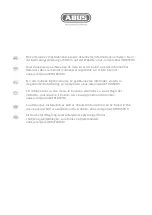
Chapter 3 - PBpro ETH Adm inistration
20
PBpro ETH - User Guide
The default IP address setting of the PBpro ETH corresponds to class C. The first three
bytes of the IP address are used to identify the network. The last byte is used for
addressing the network station. The complete default IP address is 192.168.212.212.
Assignment of the host ID to the network station and, consequently, the resulting IP
address, can be selected as desired by the network operator (administrator). He must,
however, make sure that an IP address is unique throughout the entire network.
Gateway and subnet mask
The net ID indicates whether the receiver to which a connection is to be established, is
located in the same network as the transmitter. If this part of the IP address is identical for
the transmitter and the receiver, both are located in the same network. If the net IDs are
not identical, the receiver is located in a different network.
The networks can be connected by gateways/routers.
A network can be divided into subnetworks. The net ID defined by the different network
classes is not sufficient for addressing such subnets, however; part of the host ID must
be used for addressing the subnetworks. This means that the net ID is enlarged and the
host ID is reduced accordingly.
The subnetwork defines, which part of the IP address is evaluated as a net ID and which
one as a host ID. Like the IP address the subnet mask is a 32-bit value represented in dot
notation. In binary notation, the part of the subnet mask which corresponds to the net ID is
filled with "1" digits; the part corresponding to the host ID is filled with "0" digits. Example of
a subnet mask is 255.255.255.0
With each data packet to be transmitted, the IP driver compares its own IP address with
that of the receiver. Those bits of the subnet mask which are filled with 0-digits, are
masked off in the IP address. If the evaluated bits of both IP addresses are identical, both
stations are located in the same subnet. If this is not the case, the data packet must be
passed to the gateway or router for transfer to the target network.
Gateways or routers are basically simply computers with two network cards. Ethernet
data packets received on card A are unpacked by the Ethernet driver, and the IP packet
contained in the Ethernet packet is passed to the IP driver. This driver checks whether the
target IP address belongs to the subnet connected to card B and the packet can be
transferred directly, or whether the IP packet must be passed to another gateway. In this
way, a data packet can pass several gateways or routers on its way from one network
station to another.
In addition to routers connecting one Ethernet subnet with another one, there are also
routers which change the physical medium, e.g. from Ethernet to token ring or ISDN.
Broadcast address
A broadcast address is used to send a message to all stations in a subnetwork. It is
recommended to use the highest station address in a subnetwork as broadcast address
(i. e. the broadcast address is built by setting all bits of the host ID to "1"). The PBpro ETH
does not use the broadcast address, thus you may omit it.
Содержание PBpro ETH
Страница 35: ...This page is intentionally left blank...
















































